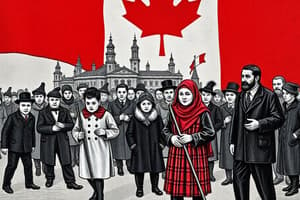Podcast
Questions and Answers
What is one reason Canada is seen as successful according to its leaders?
What is one reason Canada is seen as successful according to its leaders?
- Political isolation
- Cultural homogeneity
- Economic protectionism
- Diversity (correct)
A majority of Canadians hold negative views towards immigrants who arrived over 50 years ago.
A majority of Canadians hold negative views towards immigrants who arrived over 50 years ago.
False (B)
Which specific ethnic group saw a significant increase in hate crimes between 2015 and 2019?
Which specific ethnic group saw a significant increase in hate crimes between 2015 and 2019?
Muslims
The Prime Minister who remarked on Canada’s commitment to equality, justice, and tolerance was _______.
The Prime Minister who remarked on Canada’s commitment to equality, justice, and tolerance was _______.
Match the following years with the ethnic groups affected by exclusionary laws in Canada:
Match the following years with the ethnic groups affected by exclusionary laws in Canada:
According to a recent study, what percentage of Canadians hold negative views towards newer immigrants?
According to a recent study, what percentage of Canadians hold negative views towards newer immigrants?
Canada’s national immigration policies began to develop after Confederation.
Canada’s national immigration policies began to develop after Confederation.
What was the total number of immigrants Canada received annually between 1869 and the early 1930s?
What was the total number of immigrants Canada received annually between 1869 and the early 1930s?
Which groups were considered more desirable immigrants in Canada?
Which groups were considered more desirable immigrants in Canada?
Black immigrants were welcomed without any barriers in Canada's immigration history.
Black immigrants were welcomed without any barriers in Canada's immigration history.
What was the 'climate clause' intended to address?
What was the 'climate clause' intended to address?
Close to the bottom of the list of desired immigrants came those considered less assimilable, such as __________.
Close to the bottom of the list of desired immigrants came those considered less assimilable, such as __________.
Match the following undesirable immigrant groups with their respective descriptions:
Match the following undesirable immigrant groups with their respective descriptions:
In what year was the 'climate clause' dropped from the immigration act?
In what year was the 'climate clause' dropped from the immigration act?
The Canadian government banned Chinese immigration outright to protect relations with China.
The Canadian government banned Chinese immigration outright to protect relations with China.
What was the primary concern of immigration authorities about Black immigrants?
What was the primary concern of immigration authorities about Black immigrants?
What was the primary purpose of the Chinese Immigration Act passed in 1885?
What was the primary purpose of the Chinese Immigration Act passed in 1885?
The Chinese Exclusion Act of 1923 completely banned all forms of Chinese immigration to Canada.
The Chinese Exclusion Act of 1923 completely banned all forms of Chinese immigration to Canada.
What was the amount of the head tax imposed on Chinese immigrants by the 1885 law?
What was the amount of the head tax imposed on Chinese immigrants by the 1885 law?
The period when the Chinese Exclusion Act was in force resulted in a decrease of the Chinese-Canadian population by _____.
The period when the Chinese Exclusion Act was in force resulted in a decrease of the Chinese-Canadian population by _____.
Match the following immigration policies with their effects:
Match the following immigration policies with their effects:
Which ethnic groups faced immigration discrimination during the early 1900s in Canada?
Which ethnic groups faced immigration discrimination during the early 1900s in Canada?
PM Laurier's Minister of the Interior aimed to populate western Canada with non-white immigrants.
PM Laurier's Minister of the Interior aimed to populate western Canada with non-white immigrants.
When were Canadian immigration authorities particularly biased against immigrants born in 'enemy countries'?
When were Canadian immigration authorities particularly biased against immigrants born in 'enemy countries'?
What was the primary financial impact of the head tax on Chinese immigrants from 1885?
What was the primary financial impact of the head tax on Chinese immigrants from 1885?
How did the Chinese Exclusion Act of 1923 affect family structures within the Chinese-Canadian community?
How did the Chinese Exclusion Act of 1923 affect family structures within the Chinese-Canadian community?
What criteria did Canadian immigration authorities use to rate newcomers during the early 1900s?
What criteria did Canadian immigration authorities use to rate newcomers during the early 1900s?
What was the general attitude towards Black and Asian immigrants in Canada during the time of Clifford Sifton?
What was the general attitude towards Black and Asian immigrants in Canada during the time of Clifford Sifton?
Describe the trends in Canadian immigration policies during World War I and II.
Describe the trends in Canadian immigration policies during World War I and II.
What was the unique aspect of the head tax imposed on Chinese immigrants compared to other ethnic groups?
What was the unique aspect of the head tax imposed on Chinese immigrants compared to other ethnic groups?
What paradox exists in Canada's identity concerning immigration?
What paradox exists in Canada's identity concerning immigration?
What specific trend was observed regarding hate crimes in Canada from 2015 to 2019?
What specific trend was observed regarding hate crimes in Canada from 2015 to 2019?
How did the views of Canadians towards newer immigrants compare to those who arrived over 50 years ago?
How did the views of Canadians towards newer immigrants compare to those who arrived over 50 years ago?
What specific exclusionary practice was codified in Canadian law in 1847?
What specific exclusionary practice was codified in Canadian law in 1847?
What is the significance of the year 1923 in Canadian immigration history?
What is the significance of the year 1923 in Canadian immigration history?
How did Statistics Canada's findings in 2020 reflect the state of hate crimes in Canada?
How did Statistics Canada's findings in 2020 reflect the state of hate crimes in Canada?
What historical immigration policy was aimed at controlling the demographic makeup of Canada in the 1900s?
What historical immigration policy was aimed at controlling the demographic makeup of Canada in the 1900s?
What has been the response of a significant portion of Canadians toward refugees arriving in the last three years?
What has been the response of a significant portion of Canadians toward refugees arriving in the last three years?
What was a primary concern of Canadian immigration authorities regarding black immigrants historically?
What was a primary concern of Canadian immigration authorities regarding black immigrants historically?
What tactic did Canadian immigration officials use to identify potential Black immigrants?
What tactic did Canadian immigration officials use to identify potential Black immigrants?
What was the 'climate clause' used for in the Canadian immigration policy?
What was the 'climate clause' used for in the Canadian immigration policy?
Which groups ranked at the very bottom of Canada’s immigration desirability list?
Which groups ranked at the very bottom of Canada’s immigration desirability list?
What did Robert Borden's immigration superintendent hope regarding climate conditions for Black settlers in Canada?
What did Robert Borden's immigration superintendent hope regarding climate conditions for Black settlers in Canada?
What was a significant impact of the Chinese Immigration Act passed in 1885?
What was a significant impact of the Chinese Immigration Act passed in 1885?
What was the primary reason Canadian immigration authorities did not directly forbid Chinese immigration?
What was the primary reason Canadian immigration authorities did not directly forbid Chinese immigration?
In what year was the use of the 'climate clause' dropped from the Canadian immigration act?
In what year was the use of the 'climate clause' dropped from the Canadian immigration act?
What were the concerns immigration authorities had regarding Black immigrants in Canada?
What were the concerns immigration authorities had regarding Black immigrants in Canada?
What immigrant groups were considered more desirable by Canadian immigration policies?
What immigrant groups were considered more desirable by Canadian immigration policies?
What did the term 'less assimilable' refer to in the context of Canadian immigration policy?
What did the term 'less assimilable' refer to in the context of Canadian immigration policy?
Flashcards
Xenophobia
Xenophobia
The act of discriminating against immigrants based on their country of origin, religion, or ethnic background. This prejudice can manifest as hatred, fear, or hostility.
Hate Crime
Hate Crime
A type of hate crime that is motivated by prejudice against a particular group of people based on their ethnicity, religion, or any other identifiable characteristic.
Canada's Complex Immigration History
Canada's Complex Immigration History
Canadians have historically welcomed immigrants, but this historical narrative is incomplete, as Canada has also excluded specific groups based on their race, religion, or nationality.
Multiculturalism and Exclusion in Canada
Multiculturalism and Exclusion in Canada
Signup and view all the flashcards
Negative Perception of Newer Immigrants
Negative Perception of Newer Immigrants
Signup and view all the flashcards
Historical Exclusion of Immigrant Groups
Historical Exclusion of Immigrant Groups
Signup and view all the flashcards
Rising Islamophobia in Canada
Rising Islamophobia in Canada
Signup and view all the flashcards
Importance of Understanding Canadian Immigration History
Importance of Understanding Canadian Immigration History
Signup and view all the flashcards
Canada's Open-Door Policy
Canada's Open-Door Policy
Signup and view all the flashcards
Less Assimilable Immigrants
Less Assimilable Immigrants
Signup and view all the flashcards
Least Desirable Immigrants
Least Desirable Immigrants
Signup and view all the flashcards
Functional Anti-Blackness
Functional Anti-Blackness
Signup and view all the flashcards
Climate Clause
Climate Clause
Signup and view all the flashcards
Chinese Immigrants
Chinese Immigrants
Signup and view all the flashcards
Canada-China Relations
Canada-China Relations
Signup and view all the flashcards
Black Immigration Restrictions
Black Immigration Restrictions
Signup and view all the flashcards
What was the Chinese Immigration Act of 1885?
What was the Chinese Immigration Act of 1885?
Signup and view all the flashcards
What was the Chinese Exclusion Act of 1923?
What was the Chinese Exclusion Act of 1923?
Signup and view all the flashcards
How did Canada encourage immigration in the early 20th century?
How did Canada encourage immigration in the early 20th century?
Signup and view all the flashcards
What was "immigration hysteria" during World War I and II in Canada?
What was "immigration hysteria" during World War I and II in Canada?
Signup and view all the flashcards
What was the 'head tax' imposed on Chinese immigrants?
What was the 'head tax' imposed on Chinese immigrants?
Signup and view all the flashcards
Who was Clifford Sifton and what was his role in Canadian immigration?
Who was Clifford Sifton and what was his role in Canadian immigration?
Signup and view all the flashcards
How did the Canadian government restrict Chinese immigration?
How did the Canadian government restrict Chinese immigration?
Signup and view all the flashcards
How did early 20th-century Canadian immigration policies discriminate against non-white immigrants?
How did early 20th-century Canadian immigration policies discriminate against non-white immigrants?
Signup and view all the flashcards
Study Notes
Immigration and Exclusion in Canada
- Canada's strength lies in its diversity, a point emphasized by current and former prime ministers
- Canada has a history of embracing immigrants, but exclusionary practices have also been present
- Immigrants and their ancestors haven't always been welcomed wholeheartedly
- Xenophobia and exclusion have been codified in laws targeting various groups (Irish, Chinese, Sikhs, Jews, Japanese, Haitians)
- A recent study shows a significant portion of Canadians (one-third) hold negative views of at least one ethnic group
- Negative views are more prominent towards immigrants who arrived in the last 15 years (10%) and refugees (10%) compared to those who arrived over 50 years ago (4%).
- Hate crimes against Muslims have increased dramatically (253% from 2015-2019), reaching a record high in 2020.
Historical Barriers to Immigration
- Until the early 1930s, Canada welcomed a broad range of immigrants from various countries, including Europeans. However, some groups like Asians, Jews and Roma faced significant discrimination
- The process of excluding Black immigrants was a subtle process; not overtly hostile on paper, but through issues such as evaluating the applicant's climate suitability
- A head tax of $500 was imposed on Chinese immigrants to deter their immigration to Canada from 1885-1947
- The Chinese Immigration Act (1923) created a complete ban on most forms of Chinese immigration
- These policies resulted in significant population reductions within the Chinese community
- White immigrants were favoured early in Canada's history
- Government policies and public perception towards non-white or non-English-speaking immigrants have varied significantly throughout history to the present day
- Restrictions have included racial categorization, with individuals categorized and assessed on the basis of physical features and race
Modern Immigration and Multiculturalism
- Starting in the 1960's, Canada shifted towards assessing immigrants based on individual merits, rather than racial categorization. This marked a move towards multiculturalism.
- Canada became significantly more multiracial and multicultural starting in 1971 where non-European immigrants became the majority. This diversity became unprecedented and an unimaginable concept to previous generations
Studying That Suits You
Use AI to generate personalized quizzes and flashcards to suit your learning preferences.




